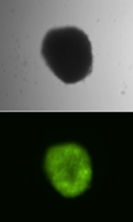Stowers scientists successfully expand bone marrow-derived stem cells in culture
Advertisement
All stem cells — regardless of their source — share the remarkable capability to replenish themselves by undergoing self-renewal. Yet, so far, efforts to grow and expand scarce hematopoietic (or blood-forming) stem cells in culture for therapeutic applications have been met with limited success.
Now, researchers at the Stowers Institute for Medical Research teased apart the molecular mechanisms enabling stem cell renewal in hematopoietic stem cells isolated from mice and successfully applied their insight to expand cultured hematopoietic stem cells a hundredfold.
Their findings, which are published in Genes & Development, demonstrate that self-renewal requires three complementary events: proliferation, active suppression of differentiation and programmed cell death during proliferation.
"The previous efforts so far to grow and expand scarce hematopoietic stem cells in culture for therapeutic applications have been met with limited success", says Stowers investigator Linheng Li, Ph.D., who led the study. "Being able to tap into stem cell's inherent potential for self-renewal could turn limited sources of hematopoietic stem cells such as umbilical cord blood into more widely available resources for hematopoietic stem cells," he adds while cautioning that their findings have yet to be replicated in human cells.
The transplantation of human hematopoietic stem cells isolated from bone marrow is used in the treatment of anemia, immune deficiencies and other diseases, including cancer. However, since bone marrow transplants require a suitable donor-recipient tissue match, the number of potential donors is limited.
Hematopoietic stem cells isolated from umbilical cord blood could be a good alternative source: Readily available and immunologically immature, they allow the donor-recipient match to be less than perfect without the risk of immune rejection of the transplant. Unfortunately, their therapeutic use is limited since umbilical cord blood contains only a small number of stem cells.
Although self-renewal is typically considered a single trait of stem cells, Li and his team wondered whether it could be pulled apart into three distinct requirements: proliferation, maintenance of the undifferentiated state, and the suppression of programmed cell death or apoptosis. "The default state of stem cells is to differentiate into a specialized cell types," explains postdoctoral researcher and first author John Perry, Ph.D. "Differentiation must be blocked in order for stem cells to undergo self-renewal."
Proliferation of stem cells in an undifferentiated state, however, calls tumor suppressor genes into action. These genes help prevent cancer by inducing a process of cell death known as apoptosis. "Consequently, self-renewal of adult stem cells must also include a third event, the active suppression of apoptosis," says Perry.
To test their hypothesis, Perry and his colleagues isolated hematopoietic stem cells from mice and analyzed two key genetic pathways — the Wnt/β-catenin and PI3K/Akt pathways. Wnt proteins had been identified as "self-renewal factors," while PI3K/Akt activation had been shown to induce proliferation and promote survival by inhibiting apoptosis.
Surprisingly, activation of the Wnt/β-catenin pathway alone blocked differentiation but eventually resulted in cell death, while activation of the PI3K/Akt pathway alone increased differentiation but facilitated cell survival. Only when both pathways were activated, did the pool of hematopoietic stem cells start expanding. "This demonstrated both pathways had to cooperate to promote self-renewal," says Perry.
Although altering both pathways drives self-renewal of hematopoietic stem cells, it also permanently blocks their ability to mature into fully functional blood cells. To sidestep the differentiation block and generate normal, functioning hematopoietic stem cells usable for therapy, the Stowers scientists used small molecules to reversibly activate both the Wnt/β-catenin and PI3K/Akt pathways in culture.
"We were able to expand the most primitive hematopoietic stem cells, which, when transplanted back into mice gave rise to all blood cell types throughout three, sequential transplantation experiments," says Li. "If similar results can be achieved using human hematopoietic stem cells from sources such as umbilical cord blood, this work is expected to have substantial clinical impact."
























































